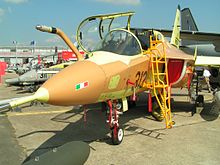|
Alenia Aeronautica
Alenia Aeronautica was an Italian aerospace company. Its subsidiaries included Alenia Aermacchi and Alenia Aeronavali. Alenia Aeronautica was also the part-owner of ATR, a joint venture with European Aeronautic Defence and Space Company (EADS). During January 2012, the company was reorganized as Alenia Aermacchi.[1] Three years later, it was fully merged into Finmeccanica, which has since reorganised itself as a more integrated business, adopting the Leonardo name for the group HistoryAlenia Aeronautica was created during 1990 by merger of IRI's Aeritalia and Selenia subsidiaries.[2] The new company was associated with several ongoing aircraft programmes and partnerships, including the multinational Eurofighter Typhoon fighter programme, the Panavia Tornado fighter-bomber. As a partner in Panavia Aircraft GmbH, Aeritalia manufactured the Tornado's wings while the other partners (British Aerospace and MBB/DASA) manufactured the rest of the airframe.[3] It also held a 20 per cent stake in Turbo-Union, a separate company formed to develop and build the RB199 engines for the aircraft.[4][5] Production of the Tornado ended in 1998; the final batch of aircraft being produced was delivered to the Royal Saudi Air Force.[6]  Alenia had 19.5% a workshare stake in the Eurofighter Typhoon programme.[7] On 27 March 1994, the maiden flight of the Eurofighter prototype took place in Bavaria.[8] In September 1998, contracts were signed for production of 148 Tranche 1 aircraft and procurement of long lead-time items for Tranche 2 aircraft.[9] Yak-130 development During 1992, Aermacchi signed a cooperation agreement with Russian aircraft company Yakovlev to support a new trainer that the firm was developing for the Russian Air Force. Aermacchi secured the right to modify and market the aircraft for the Western market.[10] The resulting aircraft first flew in 1996 and by this point, the aircraft was being marketed as the Yak/AEM-130.[11] In October 1998, it was reported that the venture was increasingly becoming an Italian-led effort due to a lack of Russian financial support.[12] In mid-2000, it was announced that differences between the two firms and a lack of backing from the Russian participants had ended the partnership. Instead, each company would pursue independent development. Yakovlev received a final payment of US$77 million for technical documents.[13][14] Yakovlev would be able to sell the Yak-130 to countries such as those in the Commonwealth of Independent States, India, Slovakia and Algeria, while Aermacchi had the right to sell the M-346 to NATO nations and others.[13] The M-346 is a highly modified version of the aircraft that developed under the joint venture, using equipment exclusively from Western manufacturers.[14][15][16] The first M-346 prototype rolled out on 7 June 2003, and conducted its maiden flight on 15 July 2004.[17] In January 2005, the Greek Ministry of Defense signed a Memorandum of Understanding (MOU) to become a partner in the programme and an industrial cooperation agreement between Alenia and the Hellenic Aerospace Industry was signed the following year.[18] In March 2008, the Chilean ENAER signed an MOU with Alenia at the FIDAE air show.[19] During May 2008, Boeing signed an MOU to cooperate on the marketing, sales, training and support of two Aermacchi trainers, the M-346 and the M-311.[20] On 18 December 2008, Aermacchi announced that the M-346 had attained a maximum speed of Mach 1.15 (1,255 km/h, 678 knots, 780 mph), claiming the occasion to be the first in which an all-Italian built aircraft had broken the sound barrier in 50 years.[21] On 20 June 2011, a Military Type Certification was granted to Alenia Aermacchi for the M-346 Master by the General Directorate for Aeronautical Armaments of the Italian Ministry of Defence in Rome.[22] C-27JIn 1995, Alenia and Lockheed Martin began discussions to improve Alenia's G.222 utility transport aircraft using C-130J's glass cockpit and a more powerful version of the G.222's T64G engine and four-blade propellers. This became the C-27J and in 1997, Alenia and Lockheed Martin formed Lockheed Martin Alenia Tactical Transport Systems (LMATTS) to develop the C-27J. The design changed to use the C-130J's AE 2100 engine and six-blade propeller.[23] Other changes include a fully digital MIL-STD-1553 systems and avionics architecture, and an updated cargo compartment for increased commonality.[24] The C-27J has a 35% increase in range and a 15% faster cruise speed than the G.222.[23] Alenia Aeronautica paired with American defense specialist L-3 Communications to form the Global Military Aircraft Systems (GMAS) joint venture to market the C-27J;[25] Boeing also joined GMAS.[26] During 2007, it was announced that the C-27J had been selected by the US Defense Department for its Joint Cargo Aircraft programme;[27] the C-27J team was awarded an initial contract worth US$2.04 billion for 78 C-27Js in June 2007.[28] Transition to LeonardoDuring 2002, Alenia Aeronautica was incorporated when Finmeccanica restructured itself, spinning off its various divisions as independent companies. Finmeccanica has since reorganised itself into a more closely integrated business, adopting the Leonardo name for the group.[29] ProductsAircraftUnmanned aerial vehiclesCollaborations
MissilesSee also
ReferencesCitations
Bibliography
External linksWikimedia Commons has media related to Alenia aircraft. |
||||||||||||||||||||||||||||||||||||||
